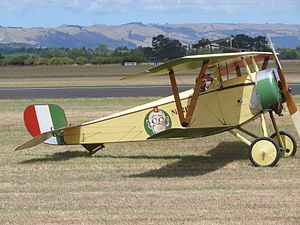Nieuport 11
| Nieuport 11 | |
|---|---|

| |
| Role | Fighter |
| Manufacturer | Nieuport |
| Designer | Gustave Delage [1] |
| Introduction | summer 1915[1][2] to 5 Jan 1916[3] |
| Primary users | |
| Number built | ≥7200[2] [note 1] |
| Wingspan | 7.49 m (24 ft 7 in)[2] - 7.54 m (24 ft 9 in)[4][5][6] |
| Engine | 80hp Le Rhône 9C rotary or 80hp Gnome Monosoupape rotary |
| Armament | top-wing Lewis |
| Ammo | 1-4 drums of 47 or 97 rounds[7] |
| Crew | 1 |
| Max Speed | 152 km/h (94 mph)[8] to 156 km/h (97 mph)[9][5][6] to 162 km/h (101 mph)[10] to 166 km/h (103 mph)[11] |
| Climb | 1,000 m (3,280 ft) in 4:00[8]-5:00[4] 2,000 m (6,560 ft) in 8:30[10][11]-10:00[8]-11:00[4] 3,000 m (9,840 ft) in 15:00[10]-18:00[4]-19:00[8] |
| Ceiling | 4,500 m (14,800 ft)[8] to 4,600 m (15,100 ft)[9][5][11][6] to 5,000 m (16,400 ft)[10] to 5,500 m (18,000 ft)[4] |
| Range | 250 km (160 mi)[10] |
| Endurance | 2:00[8] to 2:30[10][9][4][5][11][6] |
The Nieuport 11 Bébé was a small, nimble fighter that helped turn the "Fokker Scourge" of 1915. Arriving at the front in January 1916, it eventually was supplied to 21 French Escadrilles, including N124, which would later become the Lafayette Escadrille. The N11 outclassed the Fokker Eindeckers in maneuverability, but it was limited in firepower by the top-wing mounted Lewis gun. In mid-1916, it began be replaced by the re-engined Nieuport 16, to which it was very similar. Most N11's were phased out of combat duty by the end of 1916. But it was the N11 that turned the tide and many of France's most famous aces started their career in the Bébé.
The Nieuport 11 was also used in large numbers by Italy, where they were license-built by Macchi; and Russia by Dux. Small numbers were also used by Belgium, Serbia, and the RNAS.
For more information, see Wikipedia:Nieuport 11.
Timeline [note 2]

Game Data
Wings of Glory
| Maneuver | Damage | Dmg Points | Max Alt. | Climb | Points |
|---|---|---|---|---|---|
| E | B | 10 | 11 | 4 | 50 |
Plane and Crew Cards
-

1ª Sqd.
Baracca
RAF -
N3
Guynemer
RAF -

80ª Sqd.
Leonardi
RAF -
N124
Lufbery
RAF -
N67
Navarre
RAF -
Esc. N12
de Gavardie
Guntruck -
Esc. N26
Sieyes
Guntruck -
Esc. N48
de Turenne
Guntruck -
Esc. N62
Tarascon
Guntruck -
Esc. N67
Navarre
Guntruck -
Esc. N124
Hill
Guntruck -
Esc. N124
Lufbery
Guntruck -
Esc. N124
Masson
Guntruck -

1a Sqd.
Baracca
Guntruck -

76a Sqd.
Olivi
Guntruck -

80a Sqd.
Allasia
Guntruck -

80a Sqd.
Leonardi
Guntruck -

81a Sqd.
Torello
Guntruck -
1Flight, A Sqd.
Dallas
Guntruck -
2 Wing
Savory
Guntruck -
1ERE Esc.
Olieslagers
Guntruck
Card Links
Blue Max/Canvas Eagles
Miniatures and Models
1:100 Scale
- Shapeways: ReducedAircraftFactory
1:144 Scale
- Full-Color Miniatures:
- Ares: WGF122A Chaput; WGF122B De Turenne; WGF122C Ancillotto
- Shapeways Full Color: Reduced Aircraft Factory: Baracca (Ni1453), Guynemer (N836), Leonardi (Ni2123), Lufbery (N1256), Navarre (N576)
- Shapeways Paintable: ReducedAircraftFactory
- Plastic or Resin Kit: Sram 144/059 (company defunct), Valom 14413, 14420
- Metal kit: Reviresco
1:285/6mm/1:288 Scale
- Shapeways: ReducedAircraftFactory
- Metal kit: CinC MS-73
- Metal Cast: Goblintooth/H.A./MSD FRG-02
1:350 Scale
- Shapeways: Kampfflieger
Resources
Orthographic Drawings
References
- Notes
- Citations
- ↑ 1.0 1.1 1.2 Angelucci, p.53.
- ↑ 2.0 2.1 2.2 Ferry'14, p.62.
- ↑ Davilla, p.360.
- ↑ 4.0 4.1 4.2 4.3 4.4 4.5 Lamberton, pp.216-217.
- ↑ 5.0 5.1 5.2 5.3 Angelucci, p.42.
- ↑ 6.0 6.1 6.2 6.3 Argus Vol. 2, p.42.
- ↑ Kelly, p.230.
- ↑ 8.0 8.1 8.2 8.3 8.4 8.5 Durkota, p.358.
- ↑ 9.0 9.1 9.2 Munson, p.60.
- ↑ 10.0 10.1 10.2 10.3 10.4 10.5 Davilla, p.364.
- ↑ 11.0 11.1 11.2 11.3 Ferry'14, p.63.
- ↑ Philpott'13, pp.379-444.
- Bibliography
- Enzo Angelucci, ed. The Rand McNally Encyclopedia of Military Aircraft, 1914-1980. New York: The Military Press, 1983 edition. ISBN 0-517-41021-4.
- Argus Books, Airplane Archive: Aircraft of World War One, Volume 2. Great Britain: Argus Books, 1989. ISBN 0-85242-984-3
- Dr. James J. Davilla and Arthur M. Soltan. French Aircraft of the First World War. Flying Machines Press, 1997. ISBN 0-9637110-4-0.
- Alan Durkota, Thomas Darcey, and Victor Kulikov. The Imperial Russian Air Service. Flying Machines Press, 1995. ISBN 0-9637110-2-4
- Vital Ferry. French Aviation During the First World War. Paris: Histoire and Collections, 2014. ISBN 978-2-35250-370-5
- Kevin Kelly, "Belts and Drums: A Survey of First World War Aircraft Ammunition Totals". Over the Front, Vol. 5, No. 3, Autumn 1990. Walsworth Publishing Co, Inc. and The League of World War I Aviation Historians.
- W.M. Lamberton and E.F. Cheesman, Fighter Aircraft of the 1914-1918 War. Great Britain: Harleyford Publications Limited, 1960.
- Kenneth Munson, Fighters 1914-19, Attack and Training Aircraft. New York: MacMillan Publishing Co., Inc., 1976. ISBN 0713707607
- Ian Philpott, The Birth of the Royal Air Force. Great Britain: Pen & Sword Books Limited, 2013. ISBN 978-1-78159-333-2





















